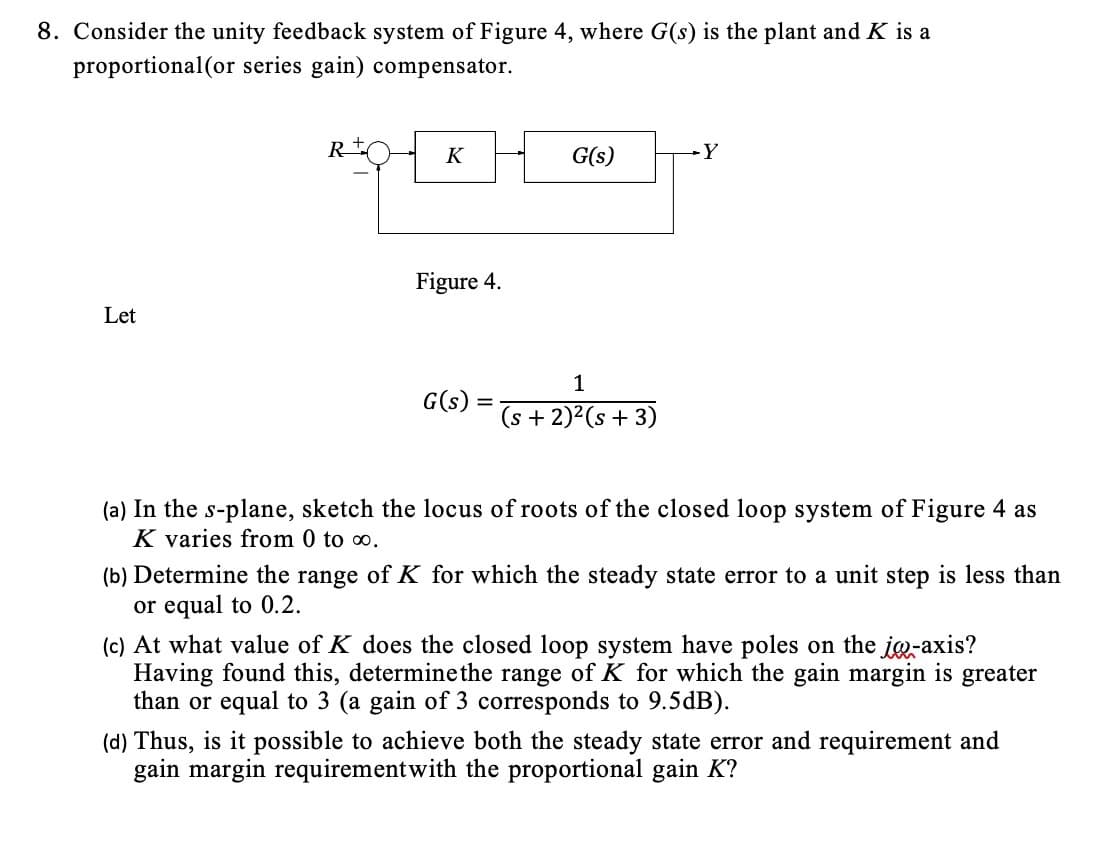8. Consider the unity feedback system of Figure 4, where G(s) is the plant and K is a proportional(or series gain) compensator. Let R K Figure 4. G(s): = G(s) 1 (s + 2)² (s + 3) -Y (a) In the s-plane, sketch the locus of roots of the closed loop system of Figure 4 as K varies from 0 to ∞. (b) Determine the range of K for which the steady state error to a unit step is less than or equal to 0.2. (c) At what value of K does the closed loop system have poles on the jo-axis? Having found this, determine the range of K for which the gain margin is greater than or equal to 3 (a gain of 3 corresponds to 9.5dB).
8. Consider the unity feedback system of Figure 4, where G(s) is the plant and K is a proportional(or series gain) compensator. Let R K Figure 4. G(s): = G(s) 1 (s + 2)² (s + 3) -Y (a) In the s-plane, sketch the locus of roots of the closed loop system of Figure 4 as K varies from 0 to ∞. (b) Determine the range of K for which the steady state error to a unit step is less than or equal to 0.2. (c) At what value of K does the closed loop system have poles on the jo-axis? Having found this, determine the range of K for which the gain margin is greater than or equal to 3 (a gain of 3 corresponds to 9.5dB).
Introductory Circuit Analysis (13th Edition)
13th Edition
ISBN:9780133923605
Author:Robert L. Boylestad
Publisher:Robert L. Boylestad
Chapter1: Introduction
Section: Chapter Questions
Problem 1P: Visit your local library (at school or home) and describe the extent to which it provides literature...
Related questions
Question
this question is under control system design subject

Transcribed Image Text:8. Consider the unity feedback system of Figure 4, where G(s) is the plant and K is a
proportional(or series gain) compensator.
Let
R
K
Figure 4.
G(s):
=
G(s)
1
(s + 2)²(s + 3)
-Y
(a) In the s-plane, sketch the locus of roots of the closed loop system of Figure 4 as
K varies from 0 to 0.
(b) Determine the range of K for which the steady state error to a unit step is less than
or equal to 0.2.
(c) At what value of K does the closed loop system have poles on the jo-axis?
Having found this, determine the range of K for which the gain margin is greater
than or equal to 3 (a gain of 3 corresponds to 9.5dB).
(d) Thus, is it possible to achieve both the steady state error and requirement and
gain margin requirement with the proportional gain K?
Expert Solution
This question has been solved!
Explore an expertly crafted, step-by-step solution for a thorough understanding of key concepts.
This is a popular solution!
Trending now
This is a popular solution!
Step by step
Solved in 5 steps with 12 images

Knowledge Booster
Learn more about
Need a deep-dive on the concept behind this application? Look no further. Learn more about this topic, electrical-engineering and related others by exploring similar questions and additional content below.Recommended textbooks for you

Introductory Circuit Analysis (13th Edition)
Electrical Engineering
ISBN:
9780133923605
Author:
Robert L. Boylestad
Publisher:
PEARSON

Delmar's Standard Textbook Of Electricity
Electrical Engineering
ISBN:
9781337900348
Author:
Stephen L. Herman
Publisher:
Cengage Learning

Programmable Logic Controllers
Electrical Engineering
ISBN:
9780073373843
Author:
Frank D. Petruzella
Publisher:
McGraw-Hill Education

Introductory Circuit Analysis (13th Edition)
Electrical Engineering
ISBN:
9780133923605
Author:
Robert L. Boylestad
Publisher:
PEARSON

Delmar's Standard Textbook Of Electricity
Electrical Engineering
ISBN:
9781337900348
Author:
Stephen L. Herman
Publisher:
Cengage Learning

Programmable Logic Controllers
Electrical Engineering
ISBN:
9780073373843
Author:
Frank D. Petruzella
Publisher:
McGraw-Hill Education

Fundamentals of Electric Circuits
Electrical Engineering
ISBN:
9780078028229
Author:
Charles K Alexander, Matthew Sadiku
Publisher:
McGraw-Hill Education

Electric Circuits. (11th Edition)
Electrical Engineering
ISBN:
9780134746968
Author:
James W. Nilsson, Susan Riedel
Publisher:
PEARSON

Engineering Electromagnetics
Electrical Engineering
ISBN:
9780078028151
Author:
Hayt, William H. (william Hart), Jr, BUCK, John A.
Publisher:
Mcgraw-hill Education,